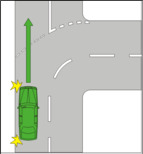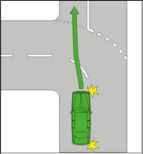 Australian Capital Territory Numbered Regulations
Australian Capital Territory Numbered Regulations Australian Capital Territory Numbered Regulations
Australian Capital Territory Numbered Regulations(1) A driver changes direction if the driver changes direction to the left or the driver changes direction to the right.
(2) A driver changes direction to the left by doing any of the following:
(a) turning left;
(b) changing marked lanes to the left;
(c) diverging to the left;
(d) entering a marked lane, or a line of traffic, to the left;
(e) moving to the left from a stationary position;
(f) turning left into a marked lane, or a line of traffic, from a median strip parking area;
(g) at a T-intersection where the continuing road curves to the right—leaving the continuing road to proceed straight ahead onto the terminating road.
(3) A driver changes direction to the right by doing any of the following:
(a) turning right;
(b) changing marked lanes to the right;
(c) diverging to the right;
(d) entering a marked lane, or a line of traffic, to the right;
(e) moving to the right from a stationary position;
(f) turning right into a marked lane, or a line of traffic, from a median strip parking area;
(g) making a U-turn;
(h) at a T-intersection where the continuing road curves to the left—leaving the continuing road to proceed straight ahead onto the terminating road.
Example 1—s (2) (g)
Driver indicating change of direction at a T-intersection where the continuing road curves to the right and the driver is proceeding straight ahead onto the terminating road

Example 2—s (3) (h)
Driver indicating change of direction at a T-intersection where the continuing road curves to the left and the driver is proceeding straight ahead onto the terminating road
